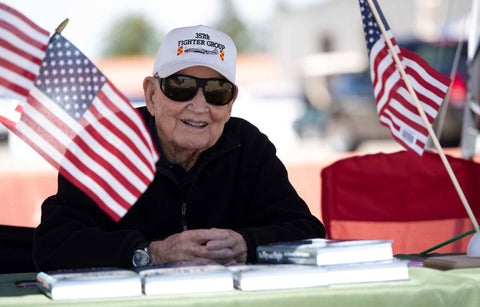
Living Legend: WWII Fighter Pilot Gets Honorary Promotion
Retired Col. Clarence E. “Bud” Anderson, a 100-year-old World War II flying ace, received an honorary promotion to brigadier general by Air Force Chief of Staff Gen. CQ Brown in a ceremony Friday at the Aerospace Museum of California.
A flying or fighter ace is a military aviator credited with shooting down five or more enemy aircraft in combat. Anderson, the highest scoring American air ace alive, is one of 14 living aces out of 1,447 recognized with the distinction by the American Fighter Aces Association, according to an Air Force release.
In an interview with Military Times, Anderson said it was “pretty special” for the Air Force chief to come to swear him in.
“He’s kind of a wrecking ball of a guy,” Brown said during the ceremony, referencing Anderson’s career and service record.
“You had a pretty thick binder, and I was going through it and some of the print was faded … but it was really good to have a chance just to read through and for me, personally, to reflect on the history of our Air Force and the impact you’ve had on our history.”
The promotion caps off an eventful year for the retired Air Force officer, who celebrated his 100th birthday in January.
Happy 100th birthday Bud Anderson! He is a World War II Triple Ace, who flew the P-51 Mustang “Old Crow” while assigned to the 357th Fighter Group “Yoxford Boys,” 8th Air Force Group - the first group to be equipped with the Mustang. #famousbirthdays #OTD #aviation #historytoday pic.twitter.com/N4Y1wspj4Y
-- San Diego Air & Space Museum (@SDASM) January 13, 2022
Born in 1922 in Oakland, California, Anderson enlisted in the Army’s Aviation Cadet Program in January 1942 and was commissioned at Luke Field, Arizona, that September, according to a Department of Veterans Affairs release.
Between November 1943 and January 1945, Anderson flew 116 combat missions with the 357th Fighter Group, also known as “Yoxford Boys,” the release said. In that time, the group destroyed over 600 enemy aircraft and produced 42 aces, including Anderson, who earned his triple ace title for destroying more than 16 enemy aircraft.
Anderson named his fighters, including his P-51 Mustang, “Old Crow.”
“I tell my non-drinking friends it’s named after the most intelligent bird that flies in the sky, but my drinking buddies know it’s named after that good ‘ole Kentucky straight bourbon whiskey,” a smirking Anderson told Military Times.
The living legend’s military career continued, however, well after World War II.
After returning to the U.S., Anderson became an Air Force test pilot before joining the Pentagon as an advanced research and development planner and then as the director of operational requirements. The aviator also spent time as commander of an F-86 fighter squadron in post-war Korea, according to an Air Force release.
Anderson’s last assignment before retiring as a colonel in March 1972 came during the Vietnam War, when he commanded the 355th Tactical Fighter Wing. During that tour, the aviator flew the F-105 Thunderchief in bombing strikes against enemy supply lines in Southeast Asia, the VA release said.
For his service, Anderson was awarded with two Legion of Merits, five Distinguished Flying Crosses, the Bronze Star, 16 Air Medals, the French Legion of Honor, and the French Croix de Guerre, the Air Force release said.
After retiring from the service, Anderson joined McDonnell Aircraft Company and in 1990 co-authored “To Fly and Fight: Memories of a Triple Ace” about his service.
“It is quite an honor to be an American Airmen, although in my day the organization had a different name,” Anderson said in a past Air Force release.
“Regardless of the name, the values remain and the mission remains the same — to fly, fight and win.”
Originally published by Military Times, our sister publication.
